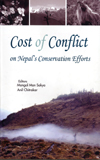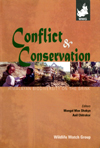|
|
Up until 2000, Nepal's conservation efforts looked promising. Despite the conflict, the number of Greater One-Horned Rhinoceros had risen to 612 from less than a hundred in the 1960s, just one indicator of success.
But Nepal today has just 409 rhinos. "From the rhino data alone, we can say conservation work has stepped back nearly two decades," says Chandra Gurung, WWF Nepal's country representative.
Chitwan National Park alone had 544 rhinos in 2000. However, as the Maoists stepped up their activities, guard posts were abandoned, giving poachers and smugglers the freedom to move around national parks, encroach on protected areas, and illegally fell timber.
"Damage is most where security posts have been set up. The army was deputed in protected areas and they have been the main targets of rebels," says ecologist Dinesh Bhuju.
In Chitwan, there were 44 armed posts of which 17 were evacuated during the insurgency. "There is aggravated rhino poaching in the area, especially after 1997," says Bhuju. Since 2000, the rhino count in Chitwan National Park has gone down to 372 from 544-a 31 percent decline in five years.
In July, park officials found a carcass of a pregnant female rhino along with its fifteen-month-old foetus in Chitwan. Its horn was missing and the rhino was covered in gunshot wounds. Altogether, six rhinos have been found dead since July end.
Despite anti-poaching campaigns and efforts by conservationists, huge profits from the sale of rhino horns and tiger bones mean local smugglers will not be deterred. A rhino horn can fetch as much as Rs 800,000/kg in Nepal, while tiger bones cost up to Rs 5,400/kg. International prices are three to four times higher.
Conservationists have no idea about the state of other species, as the conflict has made it impossible for them to go into specific areas and monitor animal activity. "The south of Annapurna has become a no-go zone for park staff," says Gurung.
The conflict has also set back the implementation of programs planned to keep conservation efforts on track. In Chitwan's Madi valley, 60,000 residents live without electricity due to the conflict, and over 15 game scouts have been killed by Maoist landmines in Parsa and Suklaphanta. "Ten of our staff were injured and abducted. The Maoists have also banned social mobilisation, which makes it very difficult for us to work," says Jhamak Karki, assistant ecologist at the Department of National Parks and Forests.
Wildlife monitoring has also suffered a setback, which is why poaching in all areas, not just the remote inaccessible ones has intensified. But poaching for food was curbed to an extent because Karki says, "the Maoists confiscated all weapons from the villagers."
Revenue generated from the exploitation of natural resources normally goes to the government and is in part put into local community development projects. That has in recent years been channelled into Maoist activities. "Even Maoists from Dhading go up to Dolpo to collect taxes on Yarchagumba. The Rs 10,000/kg royalty that should be going to the government was going to the Maoists," says Yeshe Lama, senior program officer of WWF Nepal.
But it's not all bad news. "Despite the conflict, landscape conservation has materialised, a third breeding rhino population has been established, and the concept of community owned and managed conservation areas was successfully pioneered in the Kanchenjunga Conservation Area," says Lama. The conservation project will be handed over to the local council this Friday.
This is the only way to go, say experts, because true ownership of wildlife and the forests lies with the community, and it is difficult to run successful programs without their participation. "Ten years from now, we want to see the indigenous communities as owners of wildlife and living in peace with nature," says Mangal Man Shakya of the Wildlife Watch Group.
The group has just launched two publications to show the impact of the conflict on conservation in Nepal.
Not all bad news
 Two reports Conflict & Conservation: Himalayan Biodiversity on the Brink, and Cost of Conflict: On Nepal's conservation efforts have been published by Wildlife Watch Group, which has been lobbying for wildlife issues since 1993.
Two reports Conflict & Conservation: Himalayan Biodiversity on the Brink, and Cost of Conflict: On Nepal's conservation efforts have been published by Wildlife Watch Group, which has been lobbying for wildlife issues since 1993.
Based on field reports collected by over 20 journalists who visited different national parks and protected areas, the books offer a chronology of the conflict's direct impact on wildlife.
What the books highlight does not really come as news. Maoist activities like taxation, extortion, threats to life and property, abduction, and ambushes have greatly affected conservation efforts in most national parks and protected areas.
 But there are also progressive stories of community groups, remigration of birds and empowerment of women despite the conflict. The reports also find that the losses suffered by the forests are not as severe as initially predicted. All this has been possible mainly because of the communities' commitment towards conservation.
But there are also progressive stories of community groups, remigration of birds and empowerment of women despite the conflict. The reports also find that the losses suffered by the forests are not as severe as initially predicted. All this has been possible mainly because of the communities' commitment towards conservation.
While the editors admit that the journalists who carried out the studies are not environmental experts, but political journalists with good contacts in the Nepal Army and the Maoists, the books are a solid source of information about the current situation in the national parks and protected areas.



